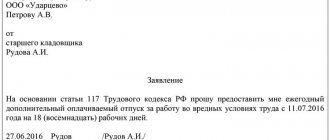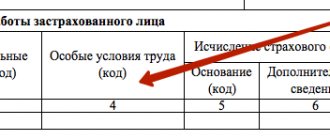Home / Labor Law / Employment / Part-time and part-time work
Back
Published: 07/22/2016
Reading time: 8 min
0
1016
The definition of part-time work is given in Article 282 of the Labor Code of the Russian Federation. It means that an employee regularly performs one or more other jobs in his free time from his main job, for which he also receives a monetary reward. The number of combined jobs is not limited in any way by law.
In order for such work to be formalized, it is necessary to conclude an employment contract with the employee and indicate in it that the work is part-time.
Part-time work is called internal if the employee performs another job in the same organization as the main one, and external if he works in different organizations.
- Registration procedure
- Important points for the employer
- For employee
Internal part-time and internal combination of positions: the difference in the formalization of relationships
An employee of the company, who is already on staff and performs a certain amount of work, decides to take on an additional load that goes beyond the scope of his current job functionality.
How can he do this? Essentially, in this case, independent labor relations between the company and the specialist come into force, which can be formalized in 2 forms:
- internal part-time job;
- combination of positions (professions).
There is a fundamental difference between the two forms that the company must understand. Namely: internal part-time work means performing work unrelated to the main one, at a time that is not occupied by the specialist’s main activity (Article 60.1, 282 of the Labor Code of the Russian Federation). In other words, the second job (internal part-time) is performed completely outside the scope of the employee’s main position.
If you have access to ConsultantPlus, find out the intricacies of registering a combination of positions, which will allow you to avoid disputes with inspectors. If you don't have access, get a free trial of online legal access.
Example:
G.V. Ivanov works as a mechanic at a manufacturing enterprise. The working day of a mechanic in production is from 9:00 to 18:00. At the same time, he decides to get a part-time job as a cleaner at the same company. He performs the labor functions of a cleaner after his working day as a mechanic ends, i.e. from 18:00 to 21:00. In this case, he does not combine positions, but performs the functions of a cleaner as his additional work on an internal part-time basis in that the same company.
Internal combination of positions assumes that a specialist continues to work within the framework of his main job duties and, in addition, during the generally established working day manages to perform other functions corresponding to another position. That is, a specialist is engaged in work to combine another position in parallel with his main work, at the same time (Article 60.2, 151 of the Labor Code of the Russian Federation).
Example:
G.V. Ivanov from the previous example works as a mechanic, but in addition, during the working day (from 9:00 to 18:00) he also has time to clean the workshop. Such relationships can be formalized as a combination of the professions of a mechanic and a cleaner within one production enterprise.
The above features also determine differences in the design of labor relations. Namely: for an internal part-time worker it is necessary to draw up a separate employment contract. When combining positions, the previous employment contract is sufficient, but an additional agreement must be issued to it.
What does the law say?
The possibility of part-time work, that is, working in an additional place in the time free from main duties, is provided for by Article 282 of the Labor Code.
A person receives additional work on a permanent basis with a salary established and reflected in the contract.
In this case, additional activities are carried out exclusively in free time (after main work or on weekends, holidays).
The main conditions for part-time work are listed in Article 44 of the Labor Code:
- The employee has a main workplace where he works. In some cases, employees hide the fact of dismissal, since the employer does not have the right to demand a work book at an additional place of work. This situation does not have any legal consequences for both the employee and the employer.
- Labor activities are carried out strictly in free time. In this case, daily employment in an additional place cannot exceed four hours.
- Employment must be accompanied by the signing of a separate contract. This is the main difference between part-time work and part-time employment.
- Additional work activity, formalized, is full-fledged. The employee receives all guarantees and payments established by labor legislation and local documents in force at the enterprise or organization.
- The salary of such an employee depends entirely on the time he actually worked. Half the rate is established for workers who work at least four hours daily. Also, an employee can work two or three hours, but at the same time he will receive a lower salary.
- A person who is a part-time worker has the right to take annual leave, receive paid sick leave, as well as accrued bonuses or other incentive payments on the same basis as other employees of the enterprise, organization or institution.
Work on combining positions: registration
If an employee wants and can work in 2 positions in the company at the same time, then the preferable option for him is to formalize additional relations with the employer in the form of combining positions. But for this it is important that the specifics of the work allow it to be performed without release from the main activity and at the main workplace. Therefore, if the second position requires, for example, moving from the main place of work (to another workshop), then such an additional load on the employee should be formalized as an internal part-time job, and not as work combining positions.
The company can formalize the combination of positions by an additional agreement to the employee’s current employment contract, which, in particular, will specify what position he intends to combine, as well as the period during which the combination of positions will take place (Article 72 of the Labor Code of the Russian Federation).
In addition, for work combining positions, the employee must, by virtue of Art. 60.2 of the Labor Code of the Russian Federation, receive an additional payment, the amount (or calculation method) of which should also be fixed in an additional agreement to the employment contract.
The grounds for drawing up such an agreement when combining positions are the following documents (depending on who initiated the combination):
- the company’s proposal to combine positions signed by the employee;
- application from an employee requesting permission to combine positions.
At the same time, it is important for the company to remember that in the work book of a specialist who combines several positions, there is no need to reflect the fact of combination, since such an obligation is not provided for by law.
In addition, companies often have a question: should the time spent by a specialist on a combined position be recorded in a time sheet? In accordance with the norms of labor legislation, combination work is not separately highlighted in the timesheet. After all, an employee performs combined work in parallel, at the same time in which he is busy with his main job. Therefore, only the hours spent on the main work need to be recorded in the time sheet.
Types of part-time jobs
Two types of part-time work.
With external part-time work, the employee is employed in several different positions at once, with several employers, and possibly even in different fields of activity. That is, his works do not overlap with each other in any way, either in type of activity or in time of completion.
With internal part-time work, an employee can, for example, do his own job, and also carry out the affairs of a sick employee. Or combine several positions on a stable or temporary basis (for example, until they find a new employee for this position).
Order on internal combination - sample
After signing the additional agreement, the company should issue a corresponding order.
Russian labor legislation does not contain a specific unified form for such an order.
At the same time, it should indicate which positions the employee will combine, for what period and for what additional payment. In this case, as a basis for combination, the order must specify the details of the additional agreement drawn up with the employee.
A sample order can be viewed on our website:
Registration of internal alignment
The employer does not have the right to assign an employee to perform any duties that go beyond the scope of the employment contract, therefore combination is allowed with the consent of the employee to perform additional work.
The registration algorithm for combining professions should look like this:
- Identifying the need to combine positions; the reason can be absolutely any, but significant for the head of the organization.
- An offer to an employee to combine his existing position with additional responsibilities that are not included in the list of his work.
- Obtaining consent and concluding an agreement to perform job duties for combining positions. In case of refusal, the employer does not have the right to fire the employee or punish him, since the desire to work part-time is a purely voluntary initiative.
- Issuance of the appropriate order. Combining positions does not fit into the employee’s work book upon his dismissal or liquidation of the organization.
In accordance with the provisions of Art. 151 of the Labor Code of the Russian Federation, combining professions is allowed when performing duties during the established working hours. It is impossible to go beyond the working day when fulfilling part-time obligations.
Completion of combining positions
As mentioned above, if a company organizes a combination of positions, then the period during which such combination will be valid is determined in advance. Therefore, the question arises: what will happen after this period?
The combination ceases to be valid, i.e. the employee is further obliged to perform only his main duties. At the same time, the legislator does not provide for the need to draw up any special document closing the combination.
Therefore, everything here remains at the discretion of the company: you can issue a special order that terminates the employee’s combined powers, or you don’t have to do this - the combination will still be considered completed (unless the company has issued another order extending the employee’s combined powers).
In addition, the Labor Code of the Russian Federation establishes that at any time, both one and the other party can stop combining unilaterally (Article 60.2 of the Labor Code of the Russian Federation). To do this, you simply need to send the appropriate notice (if the initiator of the cancellation is a company) or a statement (if the initiator is an employee) to the other party no later than 3 business days in advance.
ATTENTION! If the initiator of the termination of the combination is the company, then it makes sense for it to acquaint the employee with the relevant notice against a receipt, so that later it does not turn out that he, since he knew nothing about the cancellation, continued to work for some time, combining 2 positions, for which he demands appropriate remuneration.
Vacation and vacation pay for internal combinations
Despite the fact that the employee works part-time, annual paid leave is provided to him at his main place of work in accordance with the approved vacation schedule. During the period of leave, the employee is relieved from performing official duties in both the main and part-time work.
The law does not provide for separate vacation days for performing work in a combined position. At the same time, the combination affects the calculation of vacation payments: if in the calculation period used for calculating vacation pay (12 months before the vacation, according to Article 139 of the Labor Code of the Russian Federation), an additional payment was made to the employee for combining positions, these amounts are taken into account when calculating.
Internal part-time work according to the Labor Code of the Russian Federation
An internal part-time worker, unlike a specialist who combines positions, by virtue of the Labor Code of the Russian Federation, works in the main company in a second, additional job, but at a time that is not occupied by the main activity (Article 282, 60.1 of the Labor Code of the Russian Federation).
The Labor Code of the Russian Federation establishes a number of restrictions regarding how much working time an employee can spend on part-time work. So, if a specialist within the same organization works in two different positions at different times, then the Labor Code of the Russian Federation allows the maximum additional workload to be performed no more than 4 hours a day.
IMPORTANT! If there is a day when an employee is released from his main job for some reason, he can do part-time work throughout the working day.
For a month in the aggregate, a part-time employee has the right to work no more than half of the monthly standard of time established for the category of workers to which he belongs (Article 284 of the Labor Code of the Russian Federation). However, sometimes an employee has the right not to be guided by the specified limit.
For more information about how much time an employee has the right to spend on part-time work, see the article “Part-time work - how many hours per week?” .
An equally important question for both internal part-time workers and their employers is: how to pay for such work? Art. 285 of the Labor Code of the Russian Federation says that payment must be established in one of 3 ways:
- in proportion to the time spent working;
- according to a piecework scheme;
- on other conditions provided for in the employment contract.
For information on the specifics of additional payment up to the minimum wage for internal part-time workers, see the article . ”
In addition to the above, companies should keep in mind that if they have someone on their staff who works part-time in addition to their main job, then they are also entitled to leave of at least 28 days (Articles 114, 115 of the Labor Code of the Russian Federation). It is combined with vacation in the main position in time, however, vacation pay is accrued separately for the main position and separately for the combined work, since the employee has 2 independent employment contracts with the company (Articles 286, 287 of the Labor Code of the Russian Federation).
An important issue that concerns, in particular, part-time women, concerns the provision of maternity benefits to them.
Read more about this in the article “Maternity benefits for part-time workers .
Introductory information
First, let's define the terminology.
Very often, two different forms of employee performing additional duties are confused - part-time and part-time. The main difference between them is whether an additional employment contract is drawn up with the employee. When combined, this document is not needed (an additional agreement to an existing agreement is sufficient), but when combined, it is fundamental (Article 282 of the Labor Code of the Russian Federation). There are other differences too. Thus, combination is possible only within one organization, but part-time work can be both internal and external. In addition, the employee performs part-time work “in parallel” with his main job, that is, within the framework of “one” working time. Whereas part-time work involves working beyond normal working hours. That is why very strict conditions for the number of working hours have been established for part-time work (Article 284 of the Labor Code of the Russian Federation).
So in some cases, it will probably be more profitable to register an employee on a part-time basis - this will reduce the number of personnel documents and eliminate the need to carefully track the time spent working in the second position. Yes, and this approach can help to circumvent restrictions on part-time work.
How to apply for an internal part-time job
As stated above, when working on a part-time basis, a separate employment contract is drawn up. At the same time, he is subject to all the requirements that apply to similar contracts with regular full-time employees (not part-time employees).
ATTENTION! An internal part-time worker must have exactly two : for the main job and for a part-time job.
In particular, the employment contract must contain information about:
- companies;
- a position that a specialist undertakes to perform in addition to his main job;
- wage system;
- work and rest regime, etc. (Article 57 of the Labor Code of the Russian Federation).
As a general rule, such an agreement must be drawn up in writing, in 2 copies (one for the company and one for the employee).
ATTENTION! The employment contract must include information that the employee holds the position on an internal part-time basis.
What happens if you hire a “prohibited” part-time worker?
If you hire an employee who cannot work part-time, he must be fired under clause 11 of Art. 77 of the Labor Code of the Russian Federation - violation of the rules for concluding an employment contract, if this violation excludes the possibility of continuing work.
In some cases, the employer may be brought to administrative liability under paragraph 1 of Art. 5.27 of the Code of Administrative Offenses of the Russian Federation in the form of a warning or a fine in the amount of:
- from 1,000 to 5,000 rubles. — for officials of the organization and individual entrepreneurs;
- from 30,000 to 50,000 rub. - for legal entities.
Order and application for internal part-time work
According to the norms of the Labor Code of the Russian Federation, in order for an employment contract with an internal part-time worker to be considered concluded, such a specialist, among other documents, must submit to the company an application for employment on an internal part-time basis, in which, in particular, it should be indicated what additional work he intends to take on the employee, as well as at what hours he will perform it.
The prepared application must be submitted in writing to the company's human resources department.
As a general rule, after an employment contract is concluded, the company must issue an order confirming the hiring of a specialist (Article 68 of the Labor Code of the Russian Federation). The same is true for internal part-time workers. This means that there will be two : for the main position and part-time.
At the same time, there is a unified form of such an order (No. T-1), which you can download for free on our website.
In such an order, it is important to reflect the very fact of internal part-time work, and in addition, indicate the basic conditions of the specialist’s work, its nature and the mechanism of remuneration.
Dismissal and change of status
Another, perhaps the most significant, layer of issues related to changing the status of a part-time worker is closely related to the procedure for registering a work book. Let's consider possible situations.
Situation 1. Part-time worker quit his main job. The main question here is whether he can continue to work part-time in this case? The answer will be positive. The fact is that although the very definition of part-time work, given in Article 282 of the Labor Code of the Russian Federation, implies that a part-time worker also has a main job, the Labor Code does not provide for such a basis for dismissing a part-time worker as his dismissal from his main place of work. This means that the employer has no legal grounds for terminating the employment contract with a part-time worker in this situation.
Situation 2. A part-time worker must be assigned to the main job. In this case, the first thing the part-time worker needs to do is quit his main job. After all, to get hired for your main job, you will already need a work book, “closed” by the previous employer. Further registration of the work book by the new employer is no different from hiring an employee “from the street” - the organization’s stamp is affixed and a record of employment is made indicating the position, order details, etc.
But personnel documentation in this case can be prepared in different ways. The first way is to conclude an additional agreement to the employment contract for part-time work, making it an employment contract for the main job. That is, an order is issued to hire an employee (not a transfer!), and the appropriate changes are simply made to the personal card.
But in our opinion, a more correct way of registration would be the complete termination of the part-time relationship with the termination of the contract and the issuance of a dismissal order. And the subsequent hiring of the employee to the main job with the signing of a new employment contract. Let's explain why.
From the point of view of the Labor Code, part-time work and main work are different in nature and areas of regulation of the legal relationship that arises between the employee and the employer. These relations are very specific and are regulated by different norms of the Labor Code of the Russian Federation (Article 60.1, Chapter 44 of the Labor Code of the Russian Federation). Therefore, in our opinion, it is not enough to formalize the termination of one legal relationship and the transition to another only by order. This means that you need to terminate the part-time contract and enter into a new contract at your main place of work.
Situation 3. The main employee must be made a part-time worker. This situation is essentially a mirror image of the previous one. But, unlike it, it does not imply different options for processing personnel documentation. This is due to the fact that for such a “transfer” the employer will have to “close” the employee’s work book. After all, only the main employer can keep a work book.
So there is only one option here - dismissal and subsequent hiring. This, by the way, additionally confirms that in the previous case it is better to act in this way.
Results
Registration of imposing additional workload on a company employee can be expressed in 2 forms: internal part-time work and combination of positions. If an employee intends to perform labor functions in a position that requires distraction from his main job, then such labor relations must be formalized in the form of a separate employment contract on internal part-time work. At the same time, it is important for the company not to forget to receive a corresponding application from the employee, as well as issue an order to hire an internal part-time worker. If the additional position does not involve distraction from the main job, then the specialist can combine them, that is, work at the same time in several positions in the company. Registration of internal combination of positions is carried out by signing an additional agreement to an existing employment contract. The company should also receive a corresponding signed application from the employee and formulate an order to organize the combination of positions.
Sources: Labor Code of the Russian Federation
You can find more complete information on the topic in ConsultantPlus. Free trial access to the system for 2 days.
Let's sum it up
- The Labor Code of the Russian Federation does not allow those under 18 years of age to work part-time, as well as employees employed in harmful and dangerous working conditions, if their main job has the same working conditions.
- Prohibitions on part-time work for certain categories of employees are provided for by other federal laws.
- If a “prohibited” part-time worker is hired, he must be fired under clause 11 of Art. 77 Labor Code of the Russian Federation.
If you find an error, please select a piece of text and press Ctrl+Enter.
Part-time work without a main place of work
Is it possible to work part-time without a main place of work?
The very concept of the term “part-time job” presupposes that the person is also employed at his main place, but in practice it often happens that an employee quits his main job, but does not inform the part-time job. In this case, there are no consequences for the employer, since labor legislation does not oblige the employee to report the fact of such dismissal, and the employer to check the part-time worker.
The only point you need to pay attention to is the indication that the job will be part-time in the application for admission.
Payment
In accordance with the provisions of Art. 60.2, as well as within the framework of Art. 151 of the Labor Code of the Russian Federation, the employer is obliged to include in the agreement on internal combination of positions a clause on payment for labor duties.
Typically, the amount of the additional payment is negotiated before the agreement is signed, since the employee and the employer must come to a common denominator on the issue of paying wages for performing additional duties. On the one hand, the employer needs an employee who is ready to carry out assignments, on the other hand, the employee may refuse to perform duties if he is not satisfied with the amount of additional payment.
Payment may be determined depending on:
- The nature of the work performed.
- Psycho-emotional and physical stress that the employee must withstand.
- Difficulties in performing duties, including mental ones.
Based on these values, the employer selects the most fair amount of additional payment, and the employee either agrees to it or rejects it.
What is the difference?
Part-time or part-time employment has fundamental differences, clearly presented in the table:
| Characteristics | Part-time job | Combination |
| Conclusion of an agreement | Yes | No (additional agreement) |
| Issuance of an order for the enterprise | Yes, about the reception | Yes, about combination |
| Assigning a personnel number | Yes | No |
| Recording working hours in timesheets | Yes | No |
| Registration of a new personal card | Yes | No |
| Reflection in the work book | Yes | No |
| Work time | Half the basic norm | Within a working day |
| Reward | According to time worked or output | Fixed, in percentage or total terms |
| Providing leave | Yes | No, but the amount is taken into account in average earnings |
| Probation | Yes, but the condition is rarely applied | No |
| Termination of work upon hiring (return to position) of a permanent employee | Yes | Yes |
| Accounting for an employee when calculating the average number | Yes, proportional to the rates | No, only in single size |
| Dismissal procedure | 2 weeks notice | 3 days notice |
You can also get detailed information about the differences between these procedures from the following video:










